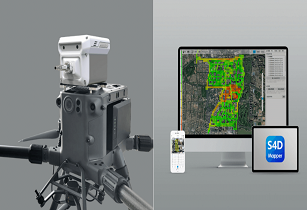According to Aeromotus, a leading and emerging drone technology company in the Middle East and African region, drone monitoring is changing the way maintenance and inspection work is conducted in the oil and gas sector
Atmospheric emissions of greenhouse gases, nitrogen oxide, sulfur dioxide, soot and other toxic components during the combustion of associated petroleum gas affect the climate, ecology and health of people in close proximity to oil and gas processing enterprises.
As a result, facilities and infrastructure are monitored in order to identify potentially dangerous spots and errors in the operation of oil and gas facilities. Increasingly, companies are looking to drones for such tasks. Drones solve several key tasks: they collect data, identify malfunctions and failures in equipment operation, examine technological units and objects that are dangerous for humans – all without stopping production
One use for them that is growing in popularity is searching for cracks and corrosion in main pipelines – a thermal imaging camera can help identify oil and gas leaks, illegal tie-ins and other damage to infrastructure.
Main flare stack monitoring tasks performed by drones include:
• Assessing the performance of the gas flare and steam systems;
• Spotting errors in the operation of oil and gas facilities;
• Identifying weak sections of the infrastructure;
• Discovering deformations of facility elements.
Benefits of drone use for flare stack monitoring
One of the main advantages of drone monitoring is the ability not to pause production for prolonged periods, since every day of downtime is a multi-million dollar loss for the company.
Before the introduction of UAVs, inspections were conducted by employees and entailed the use of helicopters and construction of complex tall scaffolding, all of which required a lot of time and money.
In addition, the data received from a drone is more accurate and analysed by specialised cutting-edge software, which makes the decision-making process more balanced and efficient than ever before.
Drone thermal imaging technology for monitoring flare stacks
Thermographic studies are the most in-demand method of inspection of oil and gas industry facilities. Drone-mounted thermal images help to identify heat sources while the pilot remains at a safe distance, reducing monitoring time and ensuring personnel safety.
Large volumes of toxic and flammable gases are burned at flare stacks, and ensuring the safe operation of these systems is a serious and important task. The use of drones to monitor oil and gas facilities is changing the way maintenance and inspection work is conducted, while ensuring environmental safety.
Finding methane leaks in a gas pipeline
Traditional gas pipeline monitoring methods are usually very laborious, involve high risk for employees and major financial and time losses, and do not always allow assessing the quality of the inspection. The Sniffer4D drone-mounted gas analyzer helps improve the efficiency of methane leak detection and speed up pipeline inspection.
Sniffer4D allows to quickly detect the concentration of methane and volatile organic compounds, as well as determine the air pollution level within flight range, to scan the air at a height of only three metres from the object.
A gas concentration map is created using Sniffer4D Mapper, designating the areas where the amount of gases significantly exceeds the allowable values. After such an inspection, trained teams can be sent to eliminate leaks and other dangerous situations.
Sniffer4D is able to sense up to nine gases and particle concentrations at one time. Users can flexibly choose or alter their sensor configurations that suit their applications and budgets.
Available parameters include:
VOCs | SO2 | CO | NO2 | O3 | PM1.0 | PM2.5 | PM10 | CxHy/CH4/LEL | H2S | HCl | TSP/PM100 | NH3 | CO2 | HCN | H2 | PH3 | Cl2 | O2 | NO | Odor (OU) | High resolution CH4 | Wind Speed & Direction | Nuclear Radiation | Gas Sampling





















